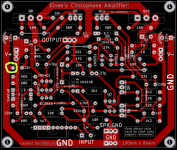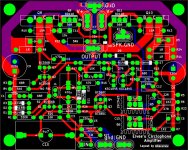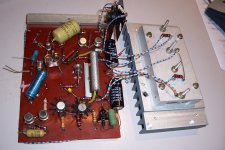Yes, it is probaly electrostatically coupled hum from the input wiring.
Did you use shielded cable? Is the metal frame of your volume pot grounded.
How is you input connector grounded, chassis....?
Is the amp board itself close to the transformer, or power or AC wiring?
Hi,
I'm not reach the state for chassis, connector, optimize grounding ... I want to make sure it work and I need some time to do the transistor swapping so I can decide which setup was the best. Current one is prototype only.
I didn't use shield wire for input but it is short, I didn't use volumn, too. I used ipod to adjust the volume. At current state, when no input, there are are light hum which can only hear when my ear are 1cm close to the speaker. When connect ipod (not turn on / turn on), the hum was gone away, I can't hear it any more (may be there but I can't hear it). So I decided to continue other things and will look back on this later.
I have some questions about components / amp:
- VAS: I have 2SC5171 && 2SC3423 && 2SC3421, base on their specs, which one was more suitable for Circlophone?
- Driver: I have 2SC1930 && 2SA1837 && ST BD140-16. Same question as above.
- Do this amp need soft start? speaker protection? On prototype without them, I had no turn on thumb, and rarely small turn off thumb sometimes.
- Does 4x 10000uf 63V sound ok for two channels? I have 23-0-23V transformer and looking for 50W into 8 ohm speaker.
- Which input cap do you use?
At current state, the amp sound very good to my ear already even I use TIP41C as ouput (will be MJL21194 on final amp).
OK, if there is hum when the input is left high-impedance, this confirms the electrostatic origin of the noise.I didn't use shield wire for input but it is short, I didn't use volumn, too. I used ipod to adjust the volume. At current state, when no input, there are are light hum which can only hear when my ear are 1cm close to the speaker. When connect ipod (not turn on / turn on), the hum was gone away, I can't hear it any more (may be there but I can't hear it).
When everything is properly shielded, this should go away even with the input open.
2SC5171 is clearly too large: it has a driver profile, with 2A Ic max and 20W Pd.- VAS: I have 2SC5171 && 2SC3423 && 2SC3421, base on their specs, which one was more suitable for Circlophone?
As a result, the collector capacitance is marginally too high.
The 3423 has a video profile, it would be OK, except that with 1.8pF capacitance implicit compensation might be insufficient, and additional B-C caps of ~4.7pF could be necessary.
The 3421 also has a relatively high capacitance: it will probably work, but marginally.
1930 is a NPN; 1837 and BD140-16 are OK- Driver: I have 2SC1930 && 2SA1837 && ST BD140-16. Same question as above.
By itself, the Circlophone does not generate power on or off thumps (using a normal bipolar supply). The turn-off noise (probably more crackling than thump is caused by the power switch arcing, and can be tackled by the usual means).- Do this amp need soft start? speaker protection? On prototype without them, I had no turn on thumb, and rarely small turn off thumb sometimes.
Regarding speaker protection, there is no built-in "magic bullet" remedy in this amplifier: if one of the OP transistors melts, it will fry the voice-coil.
It is always prudent to include some form of protection, especially if your speakers are valuable.
If you don't want to include a full protection board, a fuse inside the FB loop is a simple and safe solution: little can go wrong if you chose the right fuse size.
That is more than generous- Does 4x 10000uf 63V sound ok for two channels? I have 23-0-23V transformer and looking for 50W into 8 ohm speaker.
4.7µF results in a LF cut of ~3.3Hz: this should be OK in most cases, you can chose to cut subsonic frequencies and reduce this value, or go in the opposite direction and increase it further, but I don't think there is much point doing that- Which input cap do you use?
Thanks! That's help me a lot.
Then I will use 2SC3423 with extra cap. Which type of capacitor suitable for this case?
Is C3 value important? Could I use 150uf instead of 470uf?
I also tried to short C3 and the sound became better but the dc offset increase to about 18mV, too high? And sometimes, it sound a little weird like something wrong? What cause this high offset when short C3? Is there any solution for it?
Then I will use 2SC3423 with extra cap. Which type of capacitor suitable for this case?
Is C3 value important? Could I use 150uf instead of 470uf?
I also tried to short C3 and the sound became better but the dc offset increase to about 18mV, too high? And sometimes, it sound a little weird like something wrong? What cause this high offset when short C3? Is there any solution for it?
Last edited:
It is not critical, and it also depends on the other semi's you use. With 4.7pF, you should be OKThen I will use 2SC3423 with extra cap. Which type of capacitor suitable for this case?
C3 determines the LF roll-off; with 470µ, it is 0.7Hz and 150µ 2.2Hz.Is C3 value important? Could I use 150uf instead of 470uf?
The difference between 470µ and a short is probably psychological: 0.7Hz is such a low frequency that its effect on the audible part of the spectrum is completely negligible, unless you use your amp for special effects, like earthquake in surround sound.I also tried to short C3 and the sound became better but the dc offset increase to about 18mV, too high?
18mV with the cap shorted is very good, it means your input transistors are matched to better than 1mV.
18mV is not a problem, if you want a better figure without cap you have to hand-pick the transistors of the input pair for a low offset (and couple them thermaly).And sometimes, it sound a little weird like something wrong? What cause this high offset when short C3? Is there any solution for it?
Another solution is to use an offset adjustment, it has been described somewhere in the thread, but IMHO it is a waste of time: just use the 470µ, and everything should be fine
150µ already gives a response below the input roll-off, thus if you go higher you also have to increase the 4.7µF, otherwise it won't have a real effect.With out C3, DC offset seem floating and high. Sound more clear but have some bad on bass so C3 back again! I use 150uf tantalum 16V, do you think this value is not enough?
Increased R16 to 560 ohms thus the original amp and the ( still one, no time left for more) circlo have same gain. No more need for buffers with attenuators. Since then, no hum anymore. The hardest test in terms of analog source is direct cut LP. Here the circlo clearly leads in terms of "fine dynamics" but appears to be slower than the original amp. That however has a lead/ lag compensation so the compensation of the circlo may be the next playground.
2SC5171 works for vas (phase split area) just fine, and conveniently.
Both in every simulation and in physical testing, it works fairly close to perfect.
As a huge driver, it isn't ideal for a small signal area; however, its linearity in such a hot area saves the day by withstanding the current with utmost grace and then it manages to either break even or exceed the performance of smaller devices.
This is readily evident with the circlophone at post#1 but even more applicable when the amp is upscaled to higher voltage higher power.
This surprising suitability of a big driver device doing well at small signal is probably because that area has a high current loading suited to this size device and not at all suited to a smaller device, because linearity and strain.
P.S.
If a cap is added to its smaller sister, that will make the device noise (strongly related to device capacitance) and speed (also related to capacitance) approximately the same as a 5171, except for inferior linearity behavior. If you're adding a capacitor, your transistor is too small.
Both in every simulation and in physical testing, it works fairly close to perfect.
As a huge driver, it isn't ideal for a small signal area; however, its linearity in such a hot area saves the day by withstanding the current with utmost grace and then it manages to either break even or exceed the performance of smaller devices.
This is readily evident with the circlophone at post#1 but even more applicable when the amp is upscaled to higher voltage higher power.
This surprising suitability of a big driver device doing well at small signal is probably because that area has a high current loading suited to this size device and not at all suited to a smaller device, because linearity and strain.
P.S.
If a cap is added to its smaller sister, that will make the device noise (strongly related to device capacitance) and speed (also related to capacitance) approximately the same as a 5171, except for inferior linearity behavior. If you're adding a capacitor, your transistor is too small.
P.S.
If a cap is added to its smaller sister, that will make the device noise (strongly related to device capacitance) and speed (also related to capacitance) approximately the same as a 5171, except for inferior linearity behavior. If you're adding a capacitor, your transistor is too small.
The type of noise that engineers measure has not straightforward relationship with device capacitance. Dan probably means subjective noise.
A transistor's Cob is very nonlinear and in this circuit causes a second harmonic which rises with treble, although this effect may be buried in other sources of distortion. By choosing a low-Cob capacitor and using a normal cap to boost capacitance, the total capacitance is more linear. So it would make sense as something worth trying if you have found it to matter.
Hi,
I think I'm done with my Circlophone protype, it is quite good and I'm enjoy listening to it even I only have one channel. So I want to start make a final layout for the amp. But I need help on some points:
1. I think Q3/Q4, Q5/Q6 will work better if direct thermal?
2. Q2/Q7, Q12/Q13, What is better? direct thermal of side by side?
3. Which type C6 is preferable? MKP, MKT, Micca or N0P?
Thanks!
I think I'm done with my Circlophone protype, it is quite good and I'm enjoy listening to it even I only have one channel. So I want to start make a final layout for the amp. But I need help on some points:
1. I think Q3/Q4, Q5/Q6 will work better if direct thermal?
2. Q2/Q7, Q12/Q13, What is better? direct thermal of side by side?
3. Which type C6 is preferable? MKP, MKT, Micca or N0P?
Thanks!
Q3/Q4, certainly, especially if you make a DC-coupled version.Hi,
I think I'm done with my Circlophone protype, it is quite good and I'm enjoy listening to it even I only have one channel. So I want to start make a final layout for the amp. But I need help on some points:
1. I think Q3/Q4, Q5/Q6 will work better if direct thermal?
For Q5/Q6, it is not really required: they are already "in the loop", and even large inbalances will easily be corrected, with practically no impact on the input LTP
Side by side is sufficient, provided there is no source of heat in their immediate vicinity2. Q2/Q7, Q12/Q13, What is better? direct thermal of side by side?
Any type will do, NPO/COG is probably the easiest to source in that kind of value3. Which type C6 is preferable? MKP, MKT, Micca or N0P?
Q3/Q4, certainly, especially if you make a DC-coupled version.
For Q5/Q6, it is not really required: they are already "in the loop", and even large inbalances will easily be corrected, with practically no impact on the input LTP
Side by side is sufficient, provided there is no source of heat in their immediate vicinity
Any type will do, NPO/COG is probably the easiest to source in that kind of value
Thanks! My final layout will look like this.
Attachments
The Circlophone has successfully been built in all shapes and flavors: N and P, BJT, darlington, MOS....
All?
No, something is missing.... but the gap is going to be filled very soon, thanks to the "Steamclophone".......
Details will follow
You hipster, you!
The Circlophone has successfully been built in all shapes and flavors: N and P, BJT, darlington, MOS....
All?
No, something is missing.... but the gap is going to be filled very soon, thanks to the "Steamclophone".......
Details will follow
Interesting ... I will wait for this!
- Home
- Amplifiers
- Solid State
- ♫♪ My little cheap Circlophone© ♫♪


